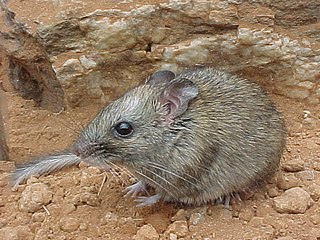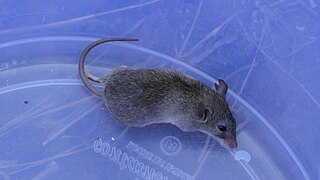
Zyzomys is a genus of rodents with unusually thick, long tails. Five species of the genus are known in Australia, where they are called rock rats or thick-tailed rats. The genus was classified by Michael Rogers Oldfield Thomas in 1909.

Batomys is a genus of rodent endemic to the Philippines. It has six extant described species.
Bunomys is a genus of rodent from Sulawesi and Buton Island.

Tokudaia is a genus of murine rodent native to Japan. Known as Ryūkyū spiny rats or spinous country-rats, population groups exist on several non-contiguous islands. Despite differences in name and appearance, they are the closest living relatives of the Eurasian field mouse (Apodemus). Of the three species, both T. osimensis and T. tokunoshimensis have lost their Y chromosome and SRY gene; the sex chromosomes of T. muenninki, on the other hand, are abnormally large.
Sooretamys angouya, also known as the rat-headed rice rat, and Paraguayan rice rat, is a rodent species from South America. It is found in northeastern Argentina, southern Brazil and Paraguay in forested areas within the Atlantic Forest and cerrado. Since 2006, it has been classified as the only species in the genus Sooretamys; previously, it was included in the genus Oryzomys. Its taxonomic history has been complex, with the names Oryzomys angouya, Oryzomys buccinatus, and Oryzomys ratticeps in use for various parts of the species at different times. Some variation in its karyotype has been reported, with 2n = 80 to 82 and FN = 88 to 90.

The Large Luzon Forest Rat, or Luzon Forest Rat is a species of rodent, the first of three to be described in the genus Bullimus. It is in the diverse family Muridae. It is found only in the Philippines. The rat has been recorded in Aurora, Benguet, and Camarines Sur provinces, and in Balbalasang, Kalinga province.

The Cutch rat or Cutch rock-rat is a species of rodent in the family Muridae.
The Elvira rat is a critically endangered species of rodent in the family Muridae. The species was first described by Sir John Ellerman in 1946. It is found only in the Eastern Ghats of Tamil Nadu, India.

Eliurus is a genus of rodent in the family Nesomyidae. It contains the following species:

Millardia is a genus of rodent in the family Muridae native to South Asia and Myanmar. It contains the following species:
Pelomys is a genus of rodent in the family Muridae endemic to Africa. It contains the following species:
Annandale's rat is a species of rodent in the family Muridae. It is found in Indonesia (Sumatra), Peninsular Malaysia, and Singapore. It was classified as Rattus annandalei until 2017, but mitochondrial and nuclear DNA show that it belongs to the rat genus Sundamys.

The tanezumi rat, also known as the Asian rat or Asian house rat, yellow-breasted or buff-breasted rat, is a species of rodent in the family Muridae. It is closely related to the black rat. It is widespread in eastern, southern and south-eastern Asia, being found in Bangladesh, Bhutan, Cambodia, China, Cocos (Keeling) Islands, Fiji, India, Indonesia, Japan, North Korea, South Korea, Laos, Malaysia, Myanmar, Nepal, the Philippines, Taiwan, Thailand, and Vietnam.
The Ceram rat, also known as the Seram Island mountain rat, is a species of rodent in the family Muridae. It is found only in Seram Island, Indonesia, where it has been recorded on Mount Mansuela. It is the only species of its genus, Nesoromys.
Sundamys is a genus of rodent in the family Muridae, found mostly in Indonesia and Malaysia. It contains the following species:

Taeromys is a genus of rodent in the family Muridae found exclusively in Sulawesi, Indonesia. It contains the following species:
Guy Graham Musser was an American zoologist. His main research was in the field of the rodent subfamily Murinae, in which he has described many new species.
The Aceh rat is a species of rodent from the family Muridae. The Aceh rat is listed as Data Deficient on the IUCN Red List because only two specimens have ever been recorded, and little is known about the species. The species was first regarded as its own species and then as a subspecies of the Malayan field rat, but was once again considered distinct due to its small body size.

Millardini is a tribe of muroid rodents in the subfamily Murinae. Species in this tribe are found in South and Southeast Asia.









